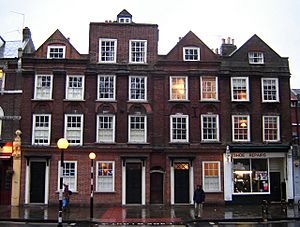Thomas Rogers (MP) facts for kids
Thomas Rogers (1735–1793) was an English businessman and banker. He was also a Member of Parliament for Coventry for a short time, from late 1780 to early 1781.
Contents
Early Life and Family Business
Thomas Rogers was born to Thomas Rogers of Amblecote, Staffordshire, and Martha Knight. His mother's father, Richard Knight, was a successful iron manufacturer.
Young Thomas started his career in business in London. He worked in a warehouse in Cheapside that his father co-owned. His family lived in Amblecote, a small village near Stourbridge. His father, also named Thomas Rogers, was a glass manufacturer. The Stourbridge area was known for glassmaking, and Amblecote had special clay used for making "glass pots" (containers for melting glass). The Rogers family had been glassmakers in Amblecote for generations.
Thomas Rogers later joined a banking business in Cornhill, London. The bank was first called Welch & Rogers around 1765. Later, in 1785, it became Welch, Rogers, Olding & Rogers. Thomas brought his two sons, Thomas Jr. and Samuel, into the business in 1784.
Thomas Rogers adopted the Presbyterian faith, which was his wife's religion. In 1767, he became the treasurer for the Newington Green meeting-house. His neighbor, Richard Price, was a minister there. Rogers and Price were part of a small group that discussed important ideas. Thomas Rogers lived at No. 52 Newington Green.
Politics and the 1780 Election
Thomas Rogers disagreed with Britain's actions during the American Revolutionary War. In April 1780, he and Richard Price helped start the Society for Constitutional Information. This group wanted to make changes to how Parliament worked. Rogers believed in reforming Parliament, but he wasn't in favor of full democracy as we know it today.
In the 1780 British general election, Rogers ran for Parliament in Coventry. He ran with Sir Thomas Hallifax. Their opponents supported the government at the time. Hallifax and Rogers had the support of the Coventry city council.
The election was very chaotic. There were riots around the voting area, and the first vote had to be stopped. A second vote was held, which lasted 24 days. Hallifax and Rogers were declared the winners by a small margin. However, the result was later overturned by Parliament in February 1781. This meant they lost their seats.
Later Life and Public Service
In 1786, Thomas Rogers was part of the group that founded the New College at Hackney. This college was a place for new ideas and learning. In 1787, a pamphlet was written against the college and sent to Rogers.
Rogers was also involved in celebrating the first anniversary of Bastille Day in France in 1790. This event marked the start of the French Revolution. He helped organize a large dinner in London for the celebration. In 1792, Rogers signed a statement from the Society of the Friends of the People. This group also pushed for political reform.
Family Life
Thomas Rogers married Mary Radford in 1760. They had eight children, but one son, Paul, died as a baby. Seven of their children lived longer than their father:
- Daniel Rogers (died 1829): He lived in Amblecote and later in Wassell Grove. He became a lawyer. He married Martha Bowles and they had ten children.
- Thomas Rogers (1761–1788).
- Samuel Rogers: He was the third son and became a famous poet. His father left him a share in the family bank and a good income. Samuel sold the family home in Newington Green in 1797. He later gave control of the bank's daily operations to his younger brother, Henry.
- Henry Rogers (died 1833): He never married.
- Martha (died 1835): She was the oldest daughter. She married the banker John Towgood in 1792.
- Maria: She married Sutton Sharpe, a brewer, in 1795. She was the mother of the banker Samuel Sharpe. Maria died in childbirth in 1806.
- Sarah (died 1855): She never married.
Bank Merger
In 1811, the Towgood family bank merged with the Rogers bank. This new bank had a long history, going back to a bank founded in 1777. John Towgood's father, Matthew Towgood III, was a Presbyterian minister who later became a banker.


